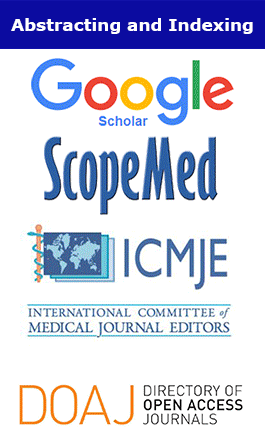Applied Medical Research. 2021;
8(2):(122-204)
Frequency of Morbidly Adherent Placenta in Previous Scarred Uterus
Naushaba Rizwan*, Faiza Saleem and Syed Farhan Uddin
Abstract
Objective: To determine the frequency of morbidly adherent placenta in previous scarred uterus in tertiary
care hospital.
Methods
Study Design: Cross sectional Study
Setting: Department of Obstetrics & Gynaecology- Unit- III , Liaquat University Hospital Hyderabad.
Sample Size: By using prevalence of placenta increta P= 13% margin of error(d)= 6% the calculated sample
size is 121 patients with the help of WHO software for sample size calculation taking 95% confidence interval.
Sample Technique: Non- probability consecutive sampling.
Inclusion Criteria
1. Patient of age between 20-40 years irrespective of gestation age or parity.
2. Patient with previous cesarean section.
3. Patient with previous myomectomy on the basis of history.
4. Patient with previous hysterotomy on the basis of history.
Exclusion Criteria
1. All patient undergoing vaginal deliveries
2. Primigravida with placenta previa
Subject and Methods: A total of 121 patients with previous caesarean section, myomectomy and hysterectomy
on the basis of history were included in this study. The outcome was assessed by observing morbidly
adherent placenta during cesarean section , by antenatal record of patient’s ultrasound for fetal wellbeing
and doppler ultrasound. All information was kept in pre-designed proforma and was analyzed through SPSS
version 21. Frequency and percentage computed for qualitative variable like previous uterine surgery, morbidity
adherence placenta, placenta increta, placenta accreta & placenta percreta. Mean ±SD was calculated
for qualitative variable i.e age, gestational age, gravida, and para. The stratification was done on age,
gestational age, gravida, para and previous uterine surgery to see the effect of these modifiers on outcome
using Chi-square test . P≤0.05 was considered as significant.
Results: The average age of the patients was 30.26±4.66 years. Frequency of morbidly adherent placenta
(MAP) in previous scarred uterus was observed in 9.09% (11/121) women. Out of 11 MAP cases 6(54.55%)
had accreta, 3(27.27%) percreta and 2(18.18%) had increta.
Conclusion: Antenatal care needs to be improved and morbid adherence of placenta should be diagnosed
at the earliest possible time. Caesarean section should be minimized to reduce the risk morbidly adherent
placenta.

